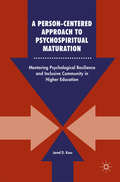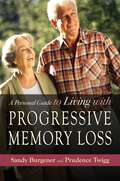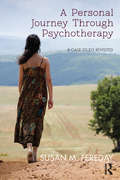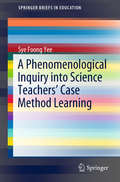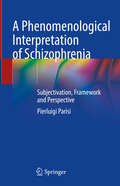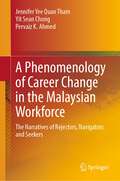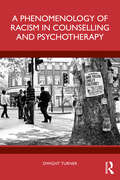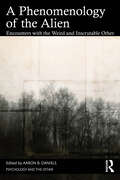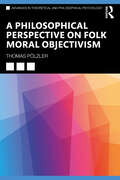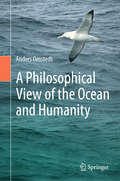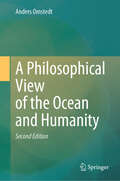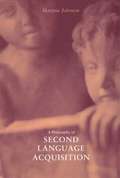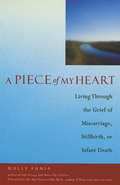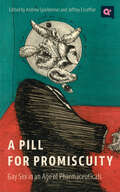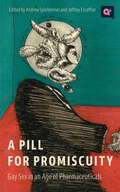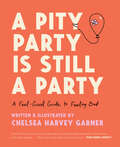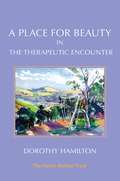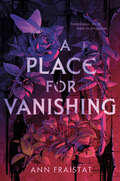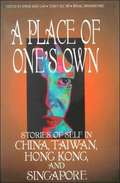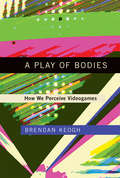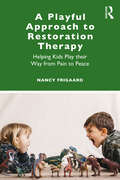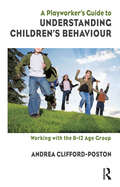- Table View
- List View
A Person-Centered Approach to Psychospiritual Maturation: Mentoring Psychological Resilience and Inclusive Community in Higher Education
by Jared D. KassThis book presents an engaged learning curriculum for higher education that helps emerging adults and professionals-in-training develop psychological resilience and community-building interpersonal skills. The curriculum mentors a person-centered process of psychospiritual maturation through growth in five dimensions of self: bio-behavioral, cognitive-sociocultural, social-emotional, existential-spiritual, and resilient worldview formation. This growth promotes student well-being and a positive campus culture, while preparing them to build cultures of health, social justice, and peace in the social systems where they will work and live.
A Personal Guide to Living with Progressive Memory Loss
by Prudence Twigg Sandy BurgenerMemory loss can create problems in every aspect of a person's life. The challenge of communicating thoughts and feelings can be made even harder by other people's negative perceptions of dementia. This book provides practical guidance for coping with progressive memory loss, and includes examples of real people who have faced similar challenges. These stories highlight both good and bad ways to deal with the problems that arise, and are also useful for describing the experiences of memory loss to friends and family. The authors suggest ways of maintaining physical and mental health by staying active and engaged in society. They also offer techniques for improving communication, preserving self-esteem and overcoming the stigma associated with memory loss. A Personal Guide to Living with Progressive Memory Loss offers inspiration and advice for anyone in the early stages of dementia. It also provides useful insight for family and friends who wish to offer support for a loved one affected by progressive memory loss.
A Personal Journey Through Psychotherapy: A Case Study Revisited
by Susan M. FeredayThis book is a personal account of the enduring value of an appropriate psychotherapeutic intervention, and is set within the author's lifespan to date. It is also a unique view of how it feels to be the subject of a published case study. Following a long period of resistance to the therapeutic process, a direct channel to the author's unconscious is established via the art of the written word. It is a first person, chronological account of the psychological signposts that relentlessly point the author toward an unavoidable therapeutic encounter, one that will ultimately have the strength to contain her frightening experience of mental disturbance. The reader is afforded the opportunity to watch the story unfold, and to draw their own academic conclusions. Some of the psychological processes are presented in 'real' time, and will help to illustrate the link between experience, theory and practice in psychotherapy.
A Phenomenological Inquiry into Science Teachers’ Case Method Learning (SpringerBriefs in Education)
by Sye Foong YeeThis book illustrates a practical application of the Case Method as a teaching technique in teacher education, and examines how learning takes place in a teacher professional development activity. It also describes teachers’ lived experience of the activity based on Clark Moustakas' 1994 guidelines for organizing and presenting a phenomenological study.
A Phenomenological Interpretation of Schizophrenia: Subjectivation, Framework and Perspective
by Pierluigi ParisiIn this book the author develops a novel, philosophically-psychopathologically founded theory of schizophrenia and its basic disorder. After the introduction with the presentation of the basic concept, the further study is divided into five chapters, each of which first gives a conceptual overview, then includes and analyzes clinical phenomena and research results in detail. The originality and creativity of the work essentially consists in using the terms mentioned as “passe-partout”, as it were, which allow the most diverse, often disparate phenomena and symptoms of schizophrenia to be viewed from an integrating point of view. The method used is phenomenological, descriptive, and interpretative, drawing on a wealth of empirical research results, but at the same time being re-viewed and reorganized in the subjective-perspective framework concept.
A Phenomenology of Career Change in the Malaysian Workforce: The Narratives of Rejectors, Navigators and Seekers
by Pervaiz K. Ahmed Jennifer Yee Tham Yit Sean ChongEvolution in economy, technology and social institutions over time have given rise to boundaryless and Protean careers that promote mobility and self-direction in managing one’s career. This has led to the phenomenon of career change whereby individuals undertake a shift from one field of work to a completely different field of work. In career change research, career changers have been studied as a collective, singular group undergoing a similar change experience, which neglects individual differences that may contrast the experience of change from one changer to another. Furthermore, the emotional experience that accompanies a career change has been examined with a primary focus on the role of positive emotions, which overlooks the role of negative emotions in career change. Thus, this book sheds light on three key narratives of career change; Rejectors, Navigators and Seekers, that were identified in a phenomenological study of career change amongst Malaysian working adults. Semi-structured interviews were conducted with 30 career changers across age, gender and ethnicity with a focus on how they made sense and meaning of their lived experience of career change within their environment and context. Each career change narrative was found to have different characteristics, motivations and behaviors respectively, which shaped their unique career change process. Negative emotions were also revealed as key drivers of the career change process, although each narrative expressed different types of negative emotions.Finally, the book also introduces an adaptive perspective to career development by way of the Adaptive Career Construal Model (ACCM) which was proposed based on the continuous bi-directional relationship between career decisions and career outcomes.
A Phenomenology of Racism in Counselling and Psychotherapy
by Dwight TurnerUsing the experiential frameworks of phenomenology and existentialism, A Phenomenology of Racism in Counselling and Psychotherapy unveils the layers of relational intersectional racism which are embedded within our culture, and its many forms.This book recognizes that race in its origins was a social system built out of white European supremacy which held within itself both class and patriarchal structures. It examines the extensive layers of societally embedded racism from those more obvious and fueled by hate, to the covert but equally as psychologically destructive, to that which then becomes more deeply internalized by those seen as the racialized other. Theoretical explorations of how our early life experiences build our relational identity around race and the long-term internalized impacts of racism, be they neurological, psychological, or trauma-based sit central to this exploration. Utilising personal and case material, Turner then details how working creatively with dreams and other means of accessing the unconscious can be essential pathways for counsellors, psychotherapists, and psychologists, as we work assist our clients (and ourselves) in working through the pain of the internalisations of racist experiences.This unique text is designed to assist professionals across the helping professions in understanding and working more wholly and effectively with the constructs of race and experiences of racism.
A Phenomenology of the Alien: Encounters with the Weird and Inscrutable Other (Psychology and the Other)
by Aaron B. DanielsA Phenomenology of the Alien: Encounters with the Weird and Inscrutable Other considers both literal and figurative experiences of the alien from a psychological, psychoanalytic and philosophical perspective.Throughout the book, the authors wrestle with the unexplained, ineffable, unspeakable, sublime, uncanny, abject and Miéville’s abcanny. This collection provides phenomenologies of encounters with the inscrutably alien from lights in the sky, dark corners of Weird fictional landscapes, architecture, technology, or the clinical symptom. The chapters examine fictional and nonfictional encounters with what exceeds the capacity to “make sense,” taking a new approach to the topic of alterity and inviting the reader to examine how these encounters reflect our contemporary condition culturally, individually, clinically, theologically and philosophically.Bridging cultural, psychoanalytic, literary, clinical, media, and religious studies, the novel approaches in this volume will be of interest to students and scholars alike.
A Philosophical Perspective on Folk Moral Objectivism
by Thomas PölzlerPhilosophers have long debated whether morality is objective. But how do lay people think about this matter? A Philosophical Perspective on Folk Moral Objectivism discusses the philosophical aspects of this question in an accessible, integrated and coherent way. The first part argues that many empirical studies have been unsuccessful in fully or exclusively measuring beliefs about moral objectivity. Still, there are a few lessons that can be drawn from them. Most importantly, lay people are not objectivists. They believe that moral statements only express desires or that their truth is relative to individuals or cultures. The book’s second part considers ways in which these empirical findings may help assess philosophical theories about moral objectivity. Overall, findings about people’s moral objectivity beliefs suggest that morality is not objective. The truth of the matter may even lie beyond the traditional objectivism/non-objectivism dichotomy. This book develops a unique perspective on a thriving new area of research. It is a valuable resource for upper level undergraduates, postgraduates and researchers in moral psychology, theoretical psychology, experimental philosophy, metaethics and philosophy of the mind.
A Philosophical View of the Ocean and Humanity (Springerbriefs In Environmental Science Ser.)
by Anders OmstedtThis book is about the ocean and about the future. It is written in two modes, a concerned analytical scientific mode and an intuitive artistic mode in which the ocean is given a voice. The disconnect in the relationship between human dependency on and feelings about the ocean is examined in a dialogue between these two modes. The book illustrates how science and the arts can be connected to increase our awareness of the state of the ocean and support behavioural change. This book is intended for everyone who would like to contribute to the sustainable use of the ocean. Includes forewords by Alice Newton, University of Algarve, Portugal and Martin Visbeck, GEOMAR, Helmholtz Centre for Ocean Research, Kiel, Germany.
A Philosophical View of the Ocean and Humanity: Second Edition
by Anders OmstedtThis book provides an overview of major threats to our blue planet. But also tools for connecting facts and values to change our often destructive behavior towards nature. The solutions to achieving an ocean in harmony with man are within us, where compassion, curiosity, empathy, courage, and creativity are needed for sustainable change. Therefore, with this book, I want to arouse your curiosity and give the reader, the courage to face the future better by introducing tools for deep diving into our outer and inner world with many hidden resources. The book brings the reader into humans' challenges with the ocean and its future. It addresses some of the main questions in the United Nations Ocean Decade initiative that aims to change how humans deal with the ocean. This unique book will stimulate a broad way of thinking by connecting analytical science thinking and intuition. In the book's first part, art and dreams are used to connect science and art. This knowledge is then applied in part II of the book, written in two modes: a concerned science mode and an intuitive, artistic mode in which the ocean is given a voice. Part III illustrates how science and art can be connected to increase our awareness of the state of the ocean and support behavioral change.
A Philosophy of Madness: The Experience of Psychotic Thinking
by Wouter KustersAn incredible publishing event: a philosopher draws on his own experience of madness as he takes readers on an unforgettble journey through the philosophy of psychosis and the psychosis of philosophy.In this book, philosopher and linguist Wouter Kusters examines the philosophy of psychosis--and the psychosis of philosophy. By analyzing the experience of psychosis in philosophical terms, Kusters not only emancipates the experience of the psychotic from medical classification, he also emancipates the philosopher from the narrowness of academia, allowing philosphers to engage in real-life praxis, philosophy in vivo. Philosophy and madness--Kusters's preferred, non-medicalized term--coexist, one mirroring the other. Drawing on his own experience of madness--two episodes of psychosis, twenty years apart--Kusters argues that psychosis presents itself to the psychotic as an inescapable truth and reality.
A Philosophy of Second Language Acquisition
by Marysia JohnsonHow does a person learn a second language? In this provocative book, Marysia Johnson proposes a new model of second language acquisition (SLA)--a model that shifts the focus from language competence (the ability to pass a language exam) to language performance (using language competently in real-life contexts). Johnson argues that current SLA theory and research is heavily biased in the direction of the cognitive and experimental scientific tradition. She draws on Vygotsky's sociocultural theory and Bakhtin's literary theory to construct an alternative framework for second language theory, research, teaching, and testing. The origin of second language acquisition is not located exclusively in the learner's mind, the author says, but in dialogical interaction conducted in a variety of settings.
A Piece of My Heart: Living Through the Grief of Miscarriage, Stillbirth, or Infant Death
by Molly Fumia“A window into the words every woman wants to hear and feel in their hearts after their hope of a healthy normal pregnancy is gone.” —Education for HealthDespite advancements in the care of those who are suffering from the loss of a child to miscarriage, stillbirth, or infant death, many parents, especially mothers, cannot or will not give themselves permission to mourn. Their feelings are real and complex, yet they are often denied a safe place to live through and ultimately befriend the grieving. A Piece of My Heart is such a friend. The moving story of a mother’s loss of her week-old son, it chronicles an amazing journey that began with denial and guilt, found its way through remembrance and reconciliation, and ended in resolution and surprising joy. A beautiful book about the necessity of grieving the loss of unlived lives, it shows readers who are going through similar experiences a shared understanding and wraps them in a warm cloak of support and friendship. Readers will be affirmed in the sacred right of all parents to mourn the loss of their children, however short their lives, and will be shown the path toward eventual healing.“This compassionate work provides an intimate journey into Fumia’s repressed grief over losing her newborn son and her ultimate reconciliation with her own guilt. Moving beyond her own circumstances, she offers direct advice to others who have lost a child to miscarriage, stillbirth, or infant death . . . Her key message is that all losses and grief deserve respect and should not be minimized regardless of the situation.” —Library Journal
A Pill for Promiscuity: Gay Sex in an Age of Pharmaceuticals (Q+ Public)
by Andrew Holleran Jeffrey Escoffier Kane Race Andrew R. Spieldenner Steve MacIsaac Daniel Felsenthal Nicolas Flores Alex Garner Deion Hawkins Pam Dore Addison Vawters Lore Tta LeMaster Ariel Sabillon Justice Jamal Jones Jeff WeinsteinFor a generation of gay men who came of age in the 1980s and 1990s, becoming sexually active meant confronting the dangers of catching and transmitting HIV. In the 21st century, however, the development of viral suppression treatments and preventative pills such as PrEP and nPEP has massively reduced the risk of acquiring HIV. Yet some of the stigma around gay male promiscuity and bareback sex has remained, inhibiting open dialogues about sexual desire, risk, and pleasure. A Pill for Promiscuity brings together academics, artists, and activists—from different generations, countries, ethnic backgrounds, and HIV statuses—to reflect on how gay sex has changed in a post-PrEP era. Some offer personal perspectives on the value of promiscuity and the sexual communities it fosters, while others critique unequal access to PrEP and the increased role Big Pharma now plays in gay life. With a diverse group of contributors that includes novelist Andrew Holleran, trans scholar Lore/tta LeMaster, cartoonist Steve MacIsaac, and pornographic film director Mister Pam, this book asks provocative questions about how we might reimagine queer sex and sexuality in the 21st century.
A Pill for Promiscuity: Gay Sex in an Age of Pharmaceuticals (Q+ Public)
by Andrew Holleran Jeffrey Escoffier Kane Race Andrew R. Spieldenner Steve MacIsaac Daniel Felsenthal Nicolas Flores Alex Garner Deion Hawkins Pam Dore Addison Vawters Lore Tta LeMaster Ariel Sabillon Justice Jamal Jones Jeff WeinsteinFor a generation of gay men who came of age in the 1980s and 1990s, becoming sexually active meant confronting the dangers of catching and transmitting HIV. In the 21st century, however, the development of viral suppression treatments and preventative pills such as PrEP and nPEP has massively reduced the risk of acquiring HIV. Yet some of the stigma around gay male promiscuity and bareback sex has remained, inhibiting open dialogues about sexual desire, risk, and pleasure. A Pill for Promiscuity brings together academics, artists, and activists—from different generations, countries, ethnic backgrounds, and HIV statuses—to reflect on how gay sex has changed in a post-PrEP era. Some offer personal perspectives on the value of promiscuity and the sexual communities it fosters, while others critique unequal access to PrEP and the increased role Big Pharma now plays in gay life. With a diverse group of contributors that includes novelist Andrew Holleran, trans scholar Lore/tta LeMaster, cartoonist Steve MacIsaac, and pornographic film director Mister Pam, this book asks provocative questions about how we might reimagine queer sex and sexuality in the 21st century.
A Pity Party Is Still a Party: A Feel-Good Guide to Feeling Bad
by Chelsea Harvey GarnerMost of us try to avoid feeling sad, but in this candid, comical, and deeply-felt book, therapist Chelsea Harvey Garner doesn’t just argue that the future will be brighter if we learn to enjoy the unenjoyable and support each other when the vibes aren’t so good, she also shows us how. What if all the advice we’ve received about “looking on the bright side” is wrong? What if sadness is actually the key to happiness, and can even be . . . fun? Garner is here to make that case. In this feel-good guide to feeling bad, she claims it’s not enough for us to tolerate hard feelings. We need to embrace them. We need to let them show by crying with others. Often. In public.Playful, at times irreverent, but always sincere, Garner is the grown-up Miss Frizzle for the therapy generation. She believes that if we want to build a world where mental health is the norm, we have to lean into connection and count on each other, even—and perhaps especially—at our worst.Through anecdotes about her own hardships and insights gained in her clinical practice, Garner illuminates the power (and embarrassment) of opening up. Featuring solo exercises, group activities, and journal prompts alongside personal essays, she invites us to see emotions in a new light and engage with them in a healthier way. A Pity Party is Still a Party helps us find the silver lining, but only after we’ve played in the rain.
A Place for Beauty in the Therapeutic Encounter
by Dorothy HamiltonA Place for Beauty in the Therapeutic Encounter is written for all psychotherapists, counsellors, and psychologists who practise under the broad banner of psychoanalytic thinking. It is also for anyone who loves beauty and wants to think more about its place in the mind.
A Place for Lost Souls: A nurse's stories of hope and despair from a 1980s psychiatric hospital
by Belinda BlackA young psychiatric nurse recalls her eye-opening experiences at one of Britain's secure mental hospitals during the 1980s.'Ultimately, my experiences as a mental health nurse have taught me that we should judge less and open our hearts more.'Belinda Black was just seventeen years old when she began working as a nursing assistant at the large and foreboding 'madhouse', as it was then known to the villagers of her hometown in the north of England. Following in the footsteps of her mother, she went on to spend a decade caring for patients with widely varying mental health problems, all locked up together and out of view of society. They included:Olek - a haunted, diminished and damaged survivor of a Nazi concentration campOrla - whose peaceful demeanour and lovely smile hid a determination to kill herselfAgatha - an extremely violent paranoid schizophrenic with a wonderful sense of humourWarren - who stabbed a person to death after he was let out.But A Place for Lost Souls is also about the other psychiatric nurses there, from those like Sister Kane who suffered from depression and found treating others a welcome distraction, to others like Belinda's friend Sally, who always had a sense of humour however dark the situation.Together, against a backdrop of rattling keys, clanging iron doors, and wards that smelled of disinfectant and stale smoke, these people came together to get through another day. Until the hospital, along with many others, had its doors closed in 1991 - the biggest change to mental healthcare in NHS history.The result is a moving, shocking but ultimately life-affirming account of a unique and noble profession, told from the frontlines. Amongst so much sadness and distress, and despite witnessing some of the darkest corners of human suffering, Belinda finds hope: in the camaraderie of her colleagues, in the patients she cares for, and in her unwavering belief that even people who have committed violent crimes are fundamentally good.(P) 2023 Quercus Editions
A Place for Lost Souls: A nurse's stories of hope and despair from a 1980s psychiatric hospital
by Belinda Black'Ultimately, my experiences as a mental health nurse have taught me that we should judge less and open our hearts more.'Belinda Black was just seventeen years old when she began working as a nursing assistant at the large and foreboding 'madhouse', as it was then known to the villagers of her hometown in the north of England. Following in the footsteps of her mother, she went on to spend a decade caring for patients with widely varying mental health problems, all locked up together and out of view of society. Some had suffered unimaginable trauma, several had violent and volatile tendencies, but amongst this Belinda found moments of joy and even friendship with her patients.Together, against a backdrop of rattling keys, clanging iron doors, and wards that smelled of disinfectant and stale smoke, these people came together to get through another day. Until the hospital, along with many others, had its doors closed in 1991 - the biggest change to mental healthcare in NHS history.The result is a moving, shocking but ultimately life-affirming account of a unique and noble profession, told from the frontlines.
A Place for Vanishing
by Ann FraistatA teen girl and her family return to her mother's childhood home, only to discover that the house's strange beauty may disguise a sinister past, in this contemporary gothic horror from the author of What We Harvest.The house was supposed to be a fresh start. That's what Libby's mom said. And after Libby&’s recent bipolar III diagnosis and the tragedy that preceded it, Libby knows she and her family need to find a new normal.But Libby&’s new home turns out to be anything but normal. Scores of bugs haunt its winding halls, towering stained-glass windows feature strange, insectile designs, and the garden teems with impossibly blue roses. And then there are the rumors. The locals, including the mysterious boy next door, tell stories about disappearances tied to the house, stretching back over a century to its first owners. Owners who supposedly hosted legendary masked séances on its grounds.Libby&’s mom refuses to hear anything that could derail their family&’s perfect new beginning, but Libby knows better. The house is keeping secrets from her, and something tells her that the key to unlocking them lies in the eerie, bug-shaped masks hidden throughout the property.We all wear masks—to hide our imperfections, to make us stronger and braver. But if Libby keeps hers on for too long, she might just lose herself—and everyone she loves.
A Place of One's Own: Stories of Self in China, Taiwan, Hong Kong, and Singapore
by Kwok-Kan Tam Wimal Dissanayake Terry Siu-Han YipThis unique collection of translations of Chinese stories explores the manifestations of "self" and the impact of place upon Chinese identity, found both on the mainland and in other Chinese communities such as Taiwan, Hong Kong, and Singapore. Though sharing a common cultural heritage, these four communities have different social, political, and economic realities; realities which are reflected in the stories' themes of self, identity, gender, and location. The stories not only demonstrate the diverse creativity of contemporary Chinese authors, they also express the aspirations and fears felt by many who live in places and circumstances where the mass media are controlled by the state and opportunities for open discussion are few and far between. Translated into English for the first time, the stories in A Place of One's Own demonstrate the exciting experimentation unfolding in the genre of the modern Chinese short story. Individually, the stories stand as important contributions to contemporary Chinese literature in translation; collectively as a comprehensive rendering of the transformation of Chinese society today.
A Play of Bodies: How We Perceive Videogames (The\mit Press Ser.)
by Brendan KeoghAn investigation of the embodied engagement between the playing body and the videogame: how player and game incorporate each other.Our bodies engage with videogames in complex and fascinating ways. Through an entanglement of eyes-on-screens, ears-at-speakers, and muscles-against-interfaces, we experience games with our senses. But, as Brendan Keogh argues in A Play of Bodies, this corporal engagement goes both ways; as we touch the videogame, it touches back, augmenting the very senses with which we perceive. Keogh investigates this merging of actual and virtual bodies and worlds, asking how our embodied sense of perception constitutes, and becomes constituted by, the phenomenon of videogame play. In short, how do we perceive videogames?Keogh works toward formulating a phenomenology of videogame experience, focusing on what happens in the embodied engagement between the playing body and the videogame, and anchoring his analysis in an eclectic series of games that range from mainstream to niche titles. Considering smartphone videogames, he proposes a notion of co-attentiveness to understand how players can feel present in a virtual world without forgetting that they are touching a screen in the actual world. He discusses the somatic basis of videogame play, whether games involve vigorous physical movement or quietly sitting on a couch with a controller; the sometimes overlooked visual and audible pleasures of videogame experience; and modes of temporality represented by character death, failure, and repetition. Finally, he considers two metaphorical characters: the “hacker,” representing the hegemonic, masculine gamers concerned with control and configuration; and the “cyborg,” less concerned with control than with embodiment and incorporation.
A Playful Approach to Restoration Therapy: Helping Kids Play their Way from Pain to Peace
by Nancy FrigaardThis accessible guide provides family and play therapists with an innovative method for addressing maladaptive emotional behavior in vulnerable children, helping them develop a practical understanding of how to diagnose, treat, and help children move from pain to peace. Drawing from Frigaard’s years of experience, this book presents the scientific model behind restoration play therapy and anticipates the multiple directions that healing and recovery might take. This guide combines creative and directive approaches to collaborative play with the vision to create deep-rooted change in clients. Including step-by-step session plans as well as introducing metaphorical "coping characters", Brutus the Blaming Badger, Sharla the Shameful Sheep, Contessa the Controlling Cow and Eddie the Escape Goat, the chapters encourage a therapeutic play environment that draws upon accessible techniques, empowering children to regain control of their responses to emotional pain. By moving between a framework of practical insight and its creative application, this text ensures therapists engage with clients where they are and build empathetic relationships with them. This book is invaluable reading for family and play therapists as well as other mental health professionals that work with children. The book encourages parents and educators to be part of the healing process, and they can also use the techniques with the children in their lives.
A Playworker's Guide to Understanding Children's Behaviour: Working with the 8-12 Age Group
by Andrea Clifford-PostonHow do I manage an aggressive child positively when I have twenty other children who need my attention? How can I develop a good relationship with a child I seem to dislike? How do I maintain a positive working relationship with the parents of a disturbed and disturbing child? Written in a jargon-free, readable style, with many real life examples, this book is a must-have resource for playworkers seeking to enhance their skills as a whole. It highlights how the way we think about children's behaviour colours the way we react to it. It offers playworkers a different way of understanding many ordinary childhood behaviours such as lying, stealing and bullying, and gives practical advice not only on management but on how practitioners can identify, trust and develop their own skills.
